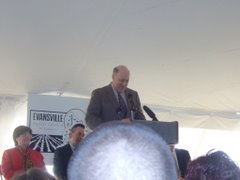Monday, October 19, 2009
Have done some very preliminary work on the wind turbine issue. This is meant as a report. I express no opinions, as I have none.
I do see one glaring scientific error in how sound pressure levels generated by wind turbines are measured. Below is a chart showing the response curve in dB of acoustic weighting curves used in measuring sound pressure levels. The “A” curve is the standard used in the USA, and certainly is the weighting curve used when rating wind turbine “noise”. This curve is incorrect in this application.
First the curves, from http://en.wikipedia.org/wiki/A-weighting
Note the rapid roll off in the response at low frequencies. Since many suspect (as do I) that the biggest wind turbine noise acceptance problem lies in low frequency noise the dB(A) scale is not an appropriate measure of wind turbine sound acceptability.
Below is a spectral representation of sound pressure levels of a wind turbine (as no information in source of how the sound spectrum was measured the spectrum as limited usefulness but is all I can find. Equipment to measure this sort of thing costs thousands of dollars.)
This graphic comes from a “pro” wind turbine site: http://www.ceere.org/rerl/publications/whitepapers/Wind_Turbine_Acoustic_Noise_Rev2006.pdf
Notice that the noise coming from this turbine is preponderantly of low frequency. The highest sound pressure levels, as you can see, are in the range of 4 to 8 hz (cycles per second) – deep “infrasound”. A sound pressure meter using “A” weighting largely rejects the “loudest” frequencies.
See the attached excel file for details.
See the spreadsheet for explanation of X axis numbering. They are third octave bands starting about 2 hz and running to 8000 hz. The bottom line is that the actual sound pressure level using the complete bandwidth is about twice as high as would be indicated by a meter calibrated in dB(A). These spectrum graphs don’t equate meter readings – in fact they are more accurate and representative – but it means that if this tower in particular would be rated about 56 dB(A) then the “actual” sound pressure level would be greater than 100 dB, and that the great majority of the sound would be generated at low and very low frequency.
Interesting, eh?
Found some good sites: http://www.acousticecology.org/srwind.html
Rock County site: http://betterplan.squarespace.com/
Monday, October 19, 2009
Mailbag: Bear Trader Writes: On Low Frequency Sound and YOU
Subscribe to:
Post Comments (Atom)






























No comments:
Post a Comment